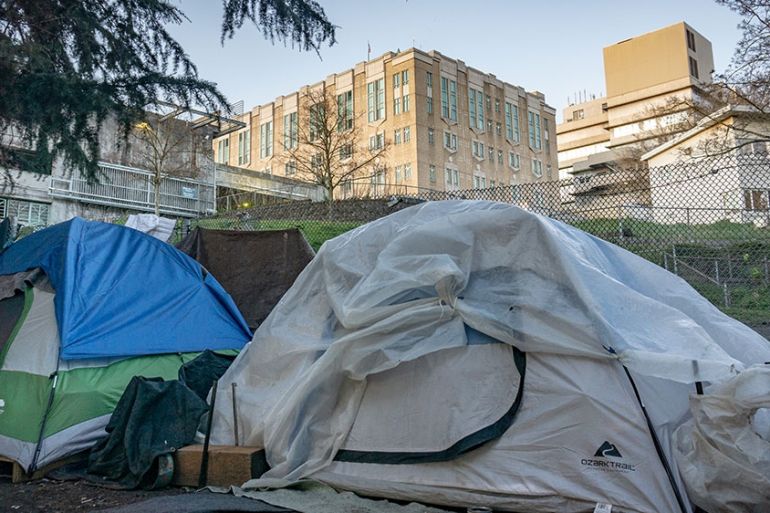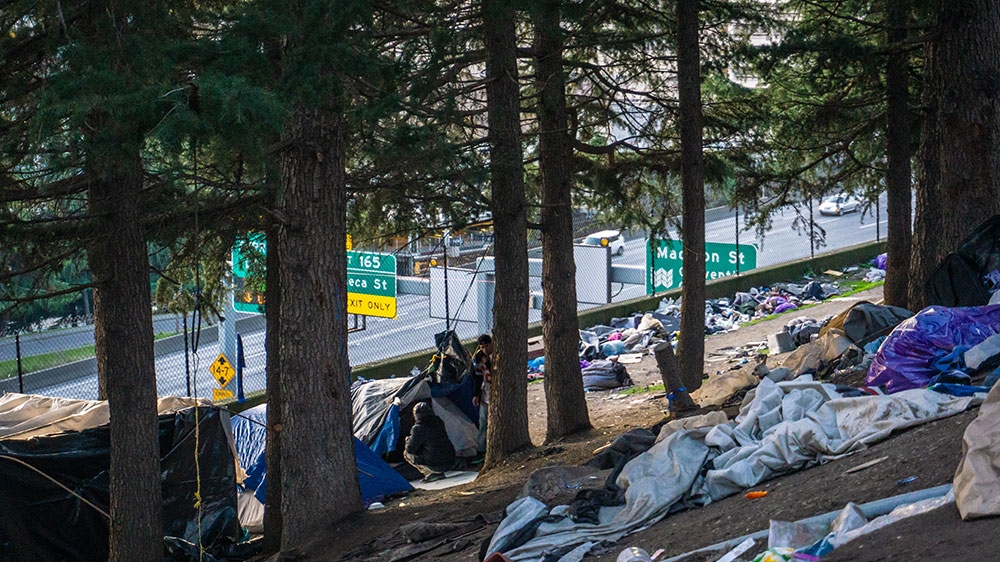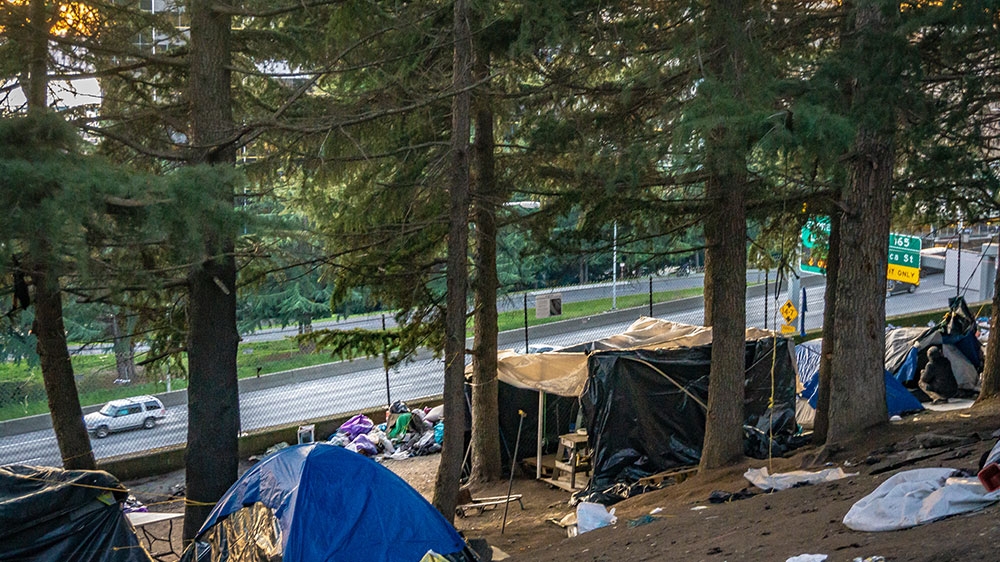Homeless amid the coronavirus outbreak
Experts say homeless individuals, already dealing with multiple diseases, are at high risk for contracting COVID-19.

Seattle, Washington – Lovey faces a dilemma. If she finds hand sanitiser, she can either use it to clean her hands, or she can drip it in a can of fibres to light a fire for a night’s worth of warmth in her tent that sits next to a highway in Seattle, Washington.
“You get pneumonia just by living in these tents,” said 53-year-old Lovey, who preferred not to use her real name.
Keep reading
list of 3 itemsCoronavirus: Which countries have confirmed cases?
What happens if you catch the new coronavirus?
Temperatures often drop close to freezing during the winter in a city also known for frequent rains. Lovey had pneumonia a few years ago, and she is coughing up green phlegm from a sinus infection now.
Nearly two weeks ago, the hospital towering over her encampment was the site of the US’s first death from the novel coronavirus that has taken almost 4,000 lives worldwide.
The Seattle area has the country’s third largest concentration of citizens like Lovey, experiencing homelessness, and the city has become the centre of the US’s battle against the spread of the novel coronavirus that has already led to at least 27 deaths, 22 of them in Washington state.
“It’s really clear we’ve been in a public health crisis,” said Alison Eisinger, executive director at the Seattle-King County Coalition on Homelessness.
“Honestly the most pressing need is housing, but that was also the most important need before a pandemic hit,” Eisinger told Al Jazeera. “The immediate need is for dollars.”

Scientists say homeless communities, like the encampment where Lovey lives, are some of the most at risk of transmission and contraction of COVID-19, the disease caused by the novel coronavirus. Many deal with multiple diseases, malnourishment from food insecurity, mental health problems and violence.
“There are just so many competing, unmet needs, that it makes it that much harder
for homeless to contend with all of this,” said Elise Riley, an epidemiologist at the University of California-San Francisco, who has studied infectious diseases in homeless populations.
In a city with one of the highest concentrations of homeless people, it’s “only a matter of time” before the city’s homeless are affected, Riley told Al Jazeera.
Almost half of Seattle’s homeless live unsheltered like Lovey, in tents, vehicles or on the streets. Only New York and Los Angeles have more homeless people.
“I’m very distressed to hear about [Lovey]. I’m worried about a lot of people,” said Eisinger. “Things are cold in Seattle right now. It is very clear there are thousands of people left outside after the shelters are full.”
Step one: Provide housing
The three states on the west coast – California, Oregon and Washington – have seen the most dramatic rise in homelessness as tech companies have made the region a bustling hub of apartment skyscrapers and high salaries and rents.
“They may be doing the best they can, keeping their hands clean, keeping their distance from others,” Riley said. “But there’s so many risk factors and unmet needs. It’s going to be extraordinarily hard for homeless folks to take the precautions that others are taking.”
The first step to combatting any one of a number of compounding pressures on the lives of homeless people, researchers and officials say, is providing housing.
“The City of Seattle is facing a public health emergency with national implications, which requires a national response, including the financial resources to bring more of our unsheltered neighbours inside,” Seattle Mayor Jenny Durkan told Al Jazeera in an email.

Eisinger was less confident in the city’s commitment to addressing the needs of vulnerable people experiencing homelessness, noting that the policies that routinely displace residents are continuing.
“The city of Seattle has a policy of forcing people in public places to move without good reason,” Eisinger said. “They’re exacerbating health problems and making it harder for people to take care of themselves and each other.”
“In King County and in cities across the country, concerns about specific risks to homeless populations underscore the need to address what we’ve long known is the only effective and durable solution to homelessness: housing first and foremost, along with case management to make sure folks are safe and have access to the support and services they need,” Seattle City councillor Teresa Mosqueda told Al Jazeera.
Mosqueda called for emergency response authorities to address the need for homeless people and volunteers to have access to sanitation sites and adequate information about prevention in multiple languages. Money, Eisinger said, is urgently needed to support staff and supplies.
“Homeless service providers are frontline first responders,” Eisinger said.
“Just as people think about needing to make sure firefighters, medical care providers, EMTs, and police are adequately staffed, the same thing is true for people who run services for communities experiencing homelessness.”
The city government plans to open three locations with another 100 beds to provide housing.
King County, where Seattle is located, continues to seek more isolation sites for people who are travelling or who cannot be at home.
Local government also helped the Downtown Emergency Service Center move its beds into a large exhibition hall so clients could ensure at least six feet between each bed, reducing the likelihood of disease spread, said Daniel Malone, executive director of the centre.
Volunteers and the food they donated were in short supply as some city residents have begun staying indoors to protect themselves from the outbreak. On Monday, shelter providers were racing against the clock to secure safe and clean housing.
There has been local pushback, however, against the expansion of space for homeless people. When the county bought a motel in Kent, south of Seattle, its mayor feared it was a “pretext” for a long-term facility for homeless individuals or a quarantine facility.
Needs compounded
The needs for those experiencing homelessness compound quickly. Homeless people are ageing, which can make them more susceptible to viral diseases, and drug use can weaken immune systems.
In a survey last year, an estimated 27 percent of homeless people in Seattle and King County had a chronic health problem, and almost 4,000 or roughly 30 percent were above 50 years old.
Just last year, a report from a local medical group found that homeless people represented a “previously unrecognised” population at increased risk for problems with respiratory infections.
“In addition to finding housing in a city where there is no affordable housing, women are also trying to dodge violence, which can mean choosing crowded sleeping situations to avoid sleeping alone on the street,” said Riley.
Scientists believe the novel coronavirus is less harmful to younger people, but conditions like stress and malnourishment can exacerbate vulnerability. In Washington state, the number of school-age children experiencing homeless has in the last decade increased sharply, now standing at roughly 40,000 students. A fifth of those are in Seattle and King County.

Eisinger has been in urgent meetings to arrange 24-hour housing to help the city’s thousands of residents on the streets meet federal recommendations for disease prevention.
“I’m confident that Seattle has a strong and experienced health department,” Eisinger said, “but what I’m not confident about is that everyone understands what needs to be done to address the needs of those experiencing homeless.”
Companies in the area have shut down their offices, and some universities have told students to go home. But for many working low-wage jobs, paid sick leave or working from home is not an option. Business is not as usual, and some workers have had to decide between staying safe and paying rent.
In addition to getting people who are currently experiencing homelessness housed, we also need to remember the importance of keeping currently housed people where they are through things like rental assistance and programmes that facilitate rapid rehousing.
Similar conditions, fewer paycheques and unpaid rent led many into homelessness in the first place.
“In addition to getting people who are currently experiencing homelessness housed,” said Riley, the epidemiologist, “we also need to remember the importance of keeping currently housed people where they are through things like rental assistance and programmes that facilitate rapid rehousing.”
Lovey, who sleeps in a tent sandwiched between a highway and hospital, said she does not know where to go for medical help. Topping off her list of needs were rubbish bags and toilet access.
“We have to be conscientious about supporting people who don’t have shelter,” Eisinger said. “People outside need information, resources and they need to be evaluated themselves.”